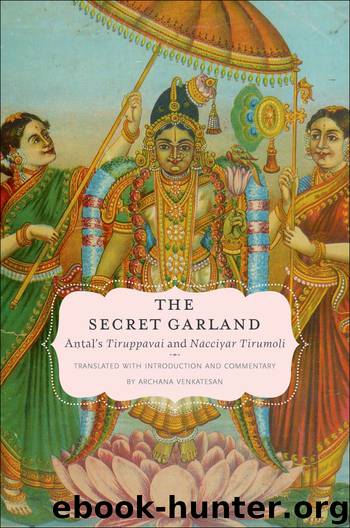The Secret Garland by Venkatesan Archana;

Author:Venkatesan, Archana;
Language: eng
Format: epub
Publisher: Oxford University Press
Published: 2010-11-19T05:00:00+00:00
Tiruppvai 23 (Mri Maai Muañcil)
Much of this verse is an extended metaphor that compares Ka to a hibernating lion that has just come awake. It begins with an extravagance of alliterative “m” sounds (mri maai muañcil) coupled with alternating hard and soft sounds (mai-k-kiantu uakum) that convey both the gentleness of the rain as well as the fiery nature of the awakening lion. His full-throated roar shatters the stillness of the surrounding forests, while his fiery gaze is fixed on the horizon. The opening image of the lion is striking and evocative and is then carried over to the end of the verse, where Ka is imagined seated on a lion throne (cikcaam). This comparison also recalls the opening metaphor of the Tiruppvai, where Ka is described as Yaod’s young lion cub (ilañ cikam). Here, however, he is full-grown and no longer the mischievous boy playing tricks, but a virile king dispensing justice, compared to a majestic lion (criya cikam). The word criya (crmai) is glossed in the commentaries as bravery and virility, but—in a stretch—also as that which is possessed of r (auspiciousness).
The literary move from the interior world of love and intimacy (akam) to the external realm (puam) of justice is marked spatially. The leonine Ka is bid to leave the mountain cave (understood in the commentaries as Nappiai’s breasts—Tiruppvai 19) and seat himself as a king on the lion-throne. The young lion cub of Tiruppvai 1 doted upon by his parents is imaged in this verse as a fully grown and fully capable king.
Therefore the girls feel obliged to awaken their divine king before he is derelict in his obligations to them. After all, during the cold winter months when animals retreat to hibernate, the girls have awakened at the crack of dawn, bathed in the cold waters of their local pond, and have seriously undertaken their quest. To emphasize the stupor-inducing effects of the cold winter months, the commentators turn to the Rmyaa. They cite the example of Rma’s monkey ally Sugrva, who was devoted to Rma, but forgot himself and his duties because of the unbearable cold.
The season of the rains also characteristically celebrates the meeting and union of lovers; so too is it with Ka. The gops believe that captured in the blissful embrace of Nappiai he forgot his duties to his devotees. uses the rain (and the season of the rains) extensively in her poetry. In Tiruppvai 4, the rain is compared to Ka (addressed with the endearment Ka, which is also the Tami version of his name). In that verse the rain brings good fortune and abundance to the cowherds and is urged to do so for its form is like their beloved lord. Theologically, in that instance, the rain is a metaphor for the grace and intervention of the teacher. In the eighth section of the Ncciyr Tirumoi, the rain and, more specifically, the rain clouds are summoned as messengers and the opening verse accuses the “lord of Vkaam” of having destroyed her womanhood (pe nrmai).
Download
This site does not store any files on its server. We only index and link to content provided by other sites. Please contact the content providers to delete copyright contents if any and email us, we'll remove relevant links or contents immediately.
Cecilia; Or, Memoirs of an Heiress — Volume 1 by Fanny Burney(32436)
Cecilia; Or, Memoirs of an Heiress — Volume 2 by Fanny Burney(31872)
Cecilia; Or, Memoirs of an Heiress — Volume 3 by Fanny Burney(31857)
The Lost Art of Listening by Michael P. Nichols(7409)
Asking the Right Questions: A Guide to Critical Thinking by M. Neil Browne & Stuart M. Keeley(5647)
We Need to Talk by Celeste Headlee(5545)
On Writing A Memoir of the Craft by Stephen King(4863)
Dialogue by Robert McKee(4323)
Pre-Suasion: A Revolutionary Way to Influence and Persuade by Robert Cialdini(4151)
I Have Something to Say: Mastering the Art of Public Speaking in an Age of Disconnection by John Bowe(3842)
Elements of Style 2017 by Richard De A'Morelli(3307)
The Book of Human Emotions by Tiffany Watt Smith(3238)
Fluent Forever: How to Learn Any Language Fast and Never Forget It by Gabriel Wyner(3031)
Name Book, The: Over 10,000 Names--Their Meanings, Origins, and Spiritual Significance by Astoria Dorothy(2940)
Good Humor, Bad Taste: A Sociology of the Joke by Kuipers Giselinde(2904)
Why I Write by George Orwell(2876)
The Art Of Deception by Kevin Mitnick(2736)
The Grammaring Guide to English Grammar with Exercises by Péter Simon(2711)
Ancient Worlds by Michael Scott(2626)
